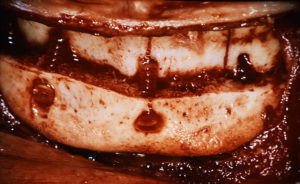The sliding genioplasty is the most well known bony reshaping procedure of the chin. It gets its name because of how it was historically described and fixed. An obliquely horizontal bone cut is made at an angle that stays below the anterior tooth roots and the mental nerve foramen. The downfractured chin bone segment was slide forward and held in its new position by wiring the two segments together.
Because the sliding genioplasty was originally wired together (before the development of small plates and screws) it was necessary that the lower bone segment stay in contact with more stable upper bone segment for stability and healing. (hence the term ‘sliding’) However with the advent of plate and screw fixation it is no longer necessary to maintain intimate bone contact between the bone segments. Plate and screw fixation also allows for a much more diverse and precisely executed dimensional repositioning of the down fracture chin bone segment.
While I have never had to remove the small plates and screws used in chin osteotomies, some patients may desire a non-metallic method of bone fixation. Resorbable plate and screw fixation systems (e.g, Lactosorb) have now been around for over two decades and can potentially be used in teh chin as well.

The use of 1.5mm or 2.0mm titanium plates and screws works very well in the chin and I have never seen a problem with them. But for the few patients who desire a rigid non-metal fixation technique sorbable lag screws can be used.
Dr. Barry Eppley
Indianapolis, Indiana


